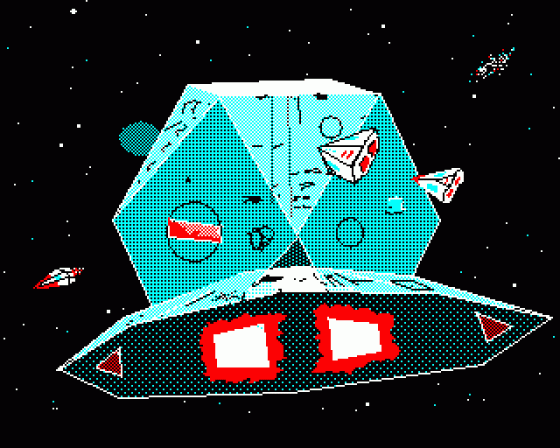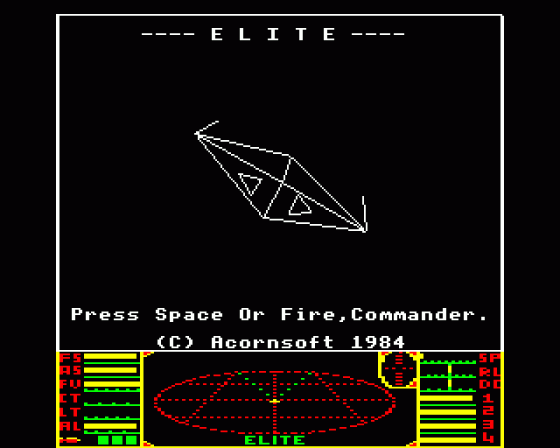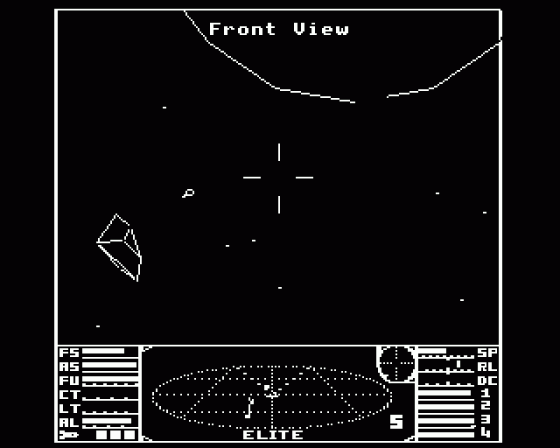
Acorn User
 1st October 1984
1st October 1984
Categories: Review: Software
Author: Tony Quinn
Publisher: Acornsoft
Machine: Acorn Electron
Published in Acorn User #027
Tony Quinn goes boldly to Cambridge on an Elite mission
Space is the final frontier, as far as Acornsoft are concerned, and the company reckons to have cracked it with the new release Elite.
This game has been the subject of the biggest security operation the company has ever mounted, to ensure no details leaked out before the launch this month. It is still so secret that even I don't have a copy!

Acornsoft spirited half a dozen journalists up to Cambridge and locked them in a room to review the game. So, this is not a full review, but my impressions after bashing away for a couple of hours. However, having written my escape clause, I must say Elite looks superb!
Imagine a subtle blending of Aviator and Starship Command, a sprinkling of the Star Wars films, shaken with a trading adventure, served up with some secret ingredients and you have Elite.
It sounds ambitious but it's all there, wrapped in a short science finction novel that sets the scene, a substantial training manual, a poster identifying the foes and friends you are likely to encounter and a postcard giving entry to the competitions that Acornsoft plans to base around the game. Not bad for £15. Plus, the disc is filled out with some special bits and pieces. You'll have to play to find out what they are - I've no idea!

The idea of the game is to start off with a simple space ship and build it and your reputation up to 'Elite' status.
Budding Han Solo's start the game with a sparsely equipped space ship and a small supply of money. The ship is docked in a station orbiting a planet. Pressing various function keys gives information on the planet and enables the raw pilot to buy various goods from food and drink to drugs. Having stocked up, the ship is launched into space and the course set for another planet.
Once a destination has been fixed, the ship goes into hyperspace and after a few seconds emerges neat the chosen planet. Then it's a dash to reach the orbiting space station before the pirates pounce. The ship has then to be docked by plotting a flightpath along a line leading from the centre of the planet into the station. The entrance is a slit, and the station is rotating, so the ship has to match rotation, otherwise it just won't fit.

Your wares can then be traded, preferably for a profit. Any credits earned can be used to fund the next flight and buy better equipment for the ship.
As you trade and equip the ship until it's bristling with weaponry and everything money can buy, it becomes tempting to play naughty. Illicit cargoes such as slaves and drugs can be bought. You could be in trouble with the law but it's a good way of making a fast buck. Then you can attack space stations for the fun of it, and even try trading with one of the deadlier planets. The risk are high, but so are the profits.
That's the theory, now for the action. The screenshot shows a typical view of space, except there are a lot of nasties around. Views to the front, rear and both sides of the ship can be called up.

Instruments at the bottom of the screen give compass, a three-dimensional map of space and other ships within range, and the status of energy banks and weaponry.
Controlling the ship takes some getting used to, as it's difficult to know where you are and which way to go, especially when someone's shooting at you. The keys are a bit awkward: there are a lot of them, and some are in strange places.
Elite apparently uses up just about every spare byte there is in the Beeb's memory (and some it shouldn't). The graphics impressed even the Cambridge gurus when Elite's two student authors showed them off. Circles and elipses are drawn in full in real time with hidden line removal. The 3D effects are astounding, and the suns have to be seen to be believed. Screen graphics Modes 4 and 5 are used at the same time to give accurate plotting and colour for the display. Screen width is reduced to speed up plotting and save memory. The reason for the strange keys? Simply because they are next to each other in the operating system's look-up table.
How much work the BBC is doing when plotting the suns and planets is shown as you fly towards them. If you look straight ahead, the game is slowed down! To get there quicker, look to the side or behind.
So how do we sum this one up? Well, it's the best game of its type and all Meteors/Starship Command/Defender/Aviator freaks will love it! Players who like adventuring might well be hooked by the trading aspects. And then on the disc version there are these things called 'missions' where a task is set. Finally, there's the unknown: no-one has yet reached the ultimate Elite status, and there's even a ship out there that no-one has yet come across. Apparently it eats spaceships, so watch out!!
Other Reviews Of Elite For The Acorn Electron
Elite
A review by Ralph Bancroft (Personal Computer News)
Elite (Acornsoft)
A review by Ian Critchley (Electron User)
Elite (Acornsoft)
A review by Dave Reeder (A&B Computing)
Elite (Acornsoft)
Mike Roberts tells you everything you've ever wanted to know about galactic trading, but were afraid to ask







